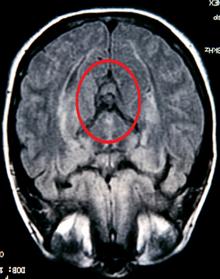Dec 10 2008
Pareidolia In The Brain
 Skeptics have long argued that pareidolia, the tendency to see familiar patterns in random stimulae, is in the brain, meaning that it is a brain phenomenon. This is not exactly what we meant, however.
Skeptics have long argued that pareidolia, the tendency to see familiar patterns in random stimulae, is in the brain, meaning that it is a brain phenomenon. This is not exactly what we meant, however.
Pamela Latrimore believes that an aparition of the Virgin Mary has appeared on an MRI scan of her brain. She also hopes that others might believe this, as she is selling her scan on Ebay to raise money for her medical bills.
This is not a particularly impressive example of pareidolia. Mary sightings are common, perhaps, because it is relatively easy to provoke pareidolia for this type of image. All that is needed is a downward curve that can look like a hooded bent head. Sometimes there is a face present, sometimes not. In this case there are some dots that the brain can fit into a very crude face. It doesn’t take much for our visual processing cortex to match a pattern to something recognizable. Picaso was evidence of this – he could evoke the impression of human figure with a single curved line.
I also note that this MRI scan is upside down. That may not be apparent to someone not used to looking at them, but it struck me immediately. The image is cropped so you can only see a bit of the writing around the image (which typically contains information about the patient and technical information about the scan), but I think you can tell from this that the writing is upside down. This is convention, of course – there is no objective up or down for these coronal views, sliced through the head horizontally. But the option of looking at the scan right-side-up or up-side-down doubles the chance for pareidolia.
This reminds me of one day as a student when I got a little bored looking at slides of microscopic sections of various organs. These slides are filled with random shapes and squiggles – a cornucopia of pareidolia. I became distracted looking for faces and other familiar shapes in the histology of the liver and pancreas. It was not difficult. Later I attended a lecture of a pathologist who had collected slides over the years of interesting microscopic pareidolia. My memory of this is now faded. I could not find anything like it with a quick search on Google. If anyone knows of something like this let me know in the comments, it would be good to link to.
One final thought – I wonder how far knowledge of pareidolia has penetrated into the broader culture. I would think the internet would have increased this substantially. There doesn’t seem to be any shortage of new cases of gullible pareidolia, however. Sounds like a question ripe for a survey.






